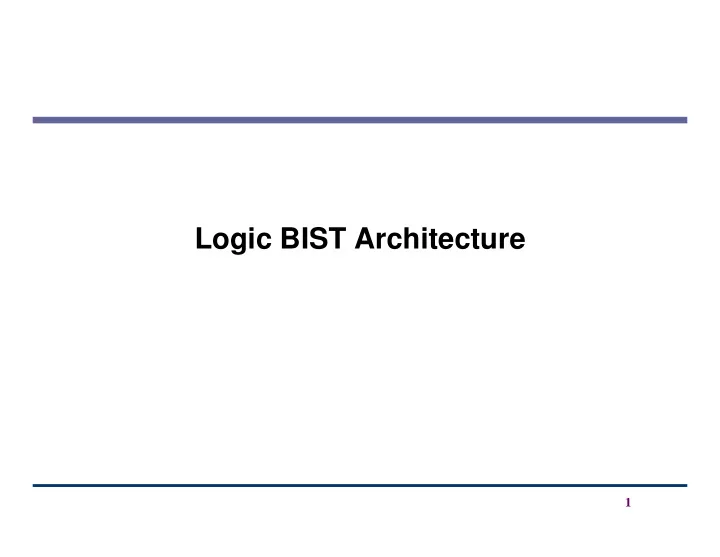

Logic BIST Architecture 1
Motivation • Complex systems with multiple chips demand elaborate logic BIST architectures – BILBO and test / clock system • Shorter test length, more BIST hardware – STUMPS & test / scan systems • Longer test length, less BIST hardware Longer test length, less BIST hardware – Circular Self-Test Path • Lowest hardware, lower fault coverage • Benefits: cheaper system test, Cost: more hardware. • Must modify fully synthesized circuit for BIST to boost fault coverage – Initialization, loop-back, test point hardware 2
Built-in Logic Block Observer (BILBO) • Combined functionality of D flip-flop, pattern generator , response compacter , & scan chain � Reset all FFs to 0 by scanning in zeros 3
Example BILBO Usage • SI – Scan In • SO – Scan Out • Characteristic polynomial : 1 + x + … + x n • CUTs A and C: BILBO1 is MISR, BILBO2 is LFSR • CUT B: BILBO1 is LFSR, BILBO2 is MISR CUT B: BILBO1 is LFSR, BILBO2 is MISR 4
BILBO Serial Scan Mode • B 1 B 2 = “00” • Dark lines show enabled data paths 5
BILBO LFSR Pattern Generator Mode • B 1 B 2 = “01” 6
BILBO in D FF (Normal) Mode • B 1 B 2 = “10” 7
BILBO in MISR Mode • B 1 B 2 = “11” 8
Test / Clock System Example • New fault set tested every clock period • Shortest possible pattern length � 10 million BIST vectors, 200 MHz test / clock � Test Time = 10,000,000 / 200 x 10 6 = 0.05 s � Shorter fault simulation time than test / scan � Shorter fault simulation time than test / scan 9
Test / Scan System • New fault tested during 1 clock vector with a complete scan chain shift • Significantly more time required per test than test / clock – Advantage: Judicious combination of scan chains and MISR Advantage: Judicious combination of scan chains and MISR reduces MISR bit width – Disadvantage: Much longer test pattern set length, causes fault simulation problems • Input patterns – time shifted & repeated – Become correlated – reduces fault detection effectiveness – Use XOR network to phase shift & decorrelate 10
STUMPS Example • SR1 … SRn – 25 full-scan chains, each 200 bits • 500 chip outputs, need 25 bit MISR (not 5000 bits) 11
STUMPS • Test procedure: 1. Scan in patterns from LFSR into all scan chains (200 clocks) 2. Switch to normal functional mode and clock 1 x with system clock 3. Scan out chains into MISR (200 clocks) where test 3. Scan out chains into MISR (200 clocks) where test results are compacted Overlap Steps 1 & 3 • • Requirements: � Every system input is driven by a scan chain � Every system output is caught in a scan chain or drives another chip being sampled 12
Alternative Test / Scan Systems 13
Summary • Logic BIST system architecture: – Advantages: • Higher fault coverage • At-speed test • Less system test, field test & diagnosis cost Less system test, field test & diagnosis cost – Disadvantage: Higher hardware cost • Architectures: BILBO, test / clock, test / scan • Needs DFT for initialization, loop-back, and test points. 14
Recommend
More recommend